If you want a glimpse of Kolkata's Durga Puja, as it used to be during the era of the landed gentry, step into Mumbai's oldest homes that have preserved this chunk of history and still celebrate it with utmost vigour

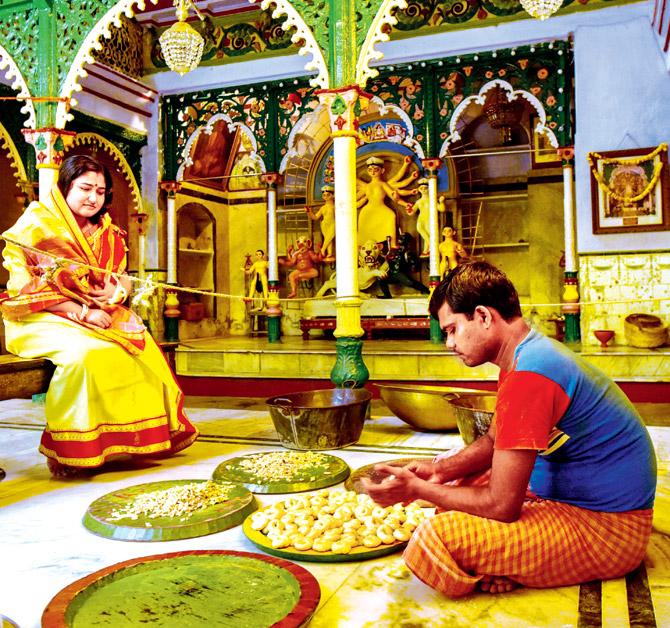
Women of the Jorasanko Daw bari gather at the thakur dalan to seek blessings of the idol
Kolkata is an early riser. From the farthest east of the country to Allahabad, the sun takes two hours to travel, which is why the City of Joy, despite its sleepy legacy, is up and about when the rest of the country is still dreaming. However, it's only at this time of the year the city needs no excuses, no threats, no alarm clocks to greet the dawn. Durga Puja is here with its call of festive duty.
ADVERTISEMENT
But, while this annual Bengali carnival sees millions milling the streets, hopping from one pandal to the next, taking in all kinds of odes to the goddess — artistic, macabre and sometimes, outlandish, there's also another, more intimate side to this festival, that quietly lingers among the misty chandeliers of the baithak-khanas, the dappled porticos and the thakur dalans of Kolkata's very ancient family homes, some of which date back to around 200 years. These are, what the Bengalis call the "bonedi baris" or homes of the aristocrats. Their antique arches, majestic pillars and grand stairways carry as much legacy as their offerings to the goddess — from the naibedya to the bhog — all of it mirroring a culture of exceptional enterprise, extravagance and an eye for detail.
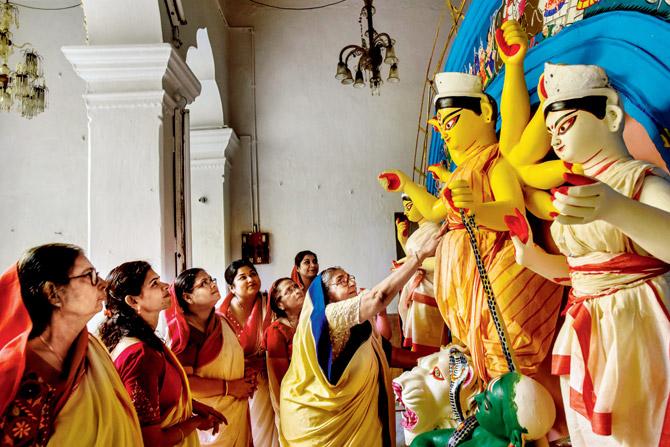
At the other Daw home, Priya Mukherjee Daw, newly married into the Narasingh Chandra Daw family, oversees the preps for the bhog. The Daws being lower caste, are not allowed to touch any item that’s part of the core puja ritual. Hence, the rope separating the family bride Priya from the Brahmin cook. Pics/Rana Chakraborty
If you could peep into their inner sanctums, you'd catch traditionally draped women sitting around mounds of coconut, jaggery and other sweet ingredients, whipping out succulent laddoos and other traditional sweets. Or, you could even spot the bhiyen — sweet-makers — stirring sugar syrup in huge, cast iron kadhais. There'd be an army of cooks and helpers peeling, chopping, kneading the dough for luchi (Bengali puri) — the constant murmur of the mortar and pestle cutting through the morning calm. Over the next few days, these lovingly tended offerings will find their way to grateful devotees, the head priest and other members of the family.
Today, in the glitz of the thematic pandals and exquisite craftsmanship of idols, these old-world pujas may have been relegated to the periphery, however, the doors of the homes of cultural elites are still open for anyone wanting to catch a glimpse of history. Long before revelry overshadowed ritual, devotees would throng to these homes to take in the splendour of the pujo as celebrated by the influential and wealthy families. What was celebrated by a handful of zamindars in the wealthier parts of Bengal, became a game of one-upmanship, with each of them trying to outdo the other in pomp and revelry. In Calcutta, it was often to woo the sahibs of the East India Company who would be guests of honour.
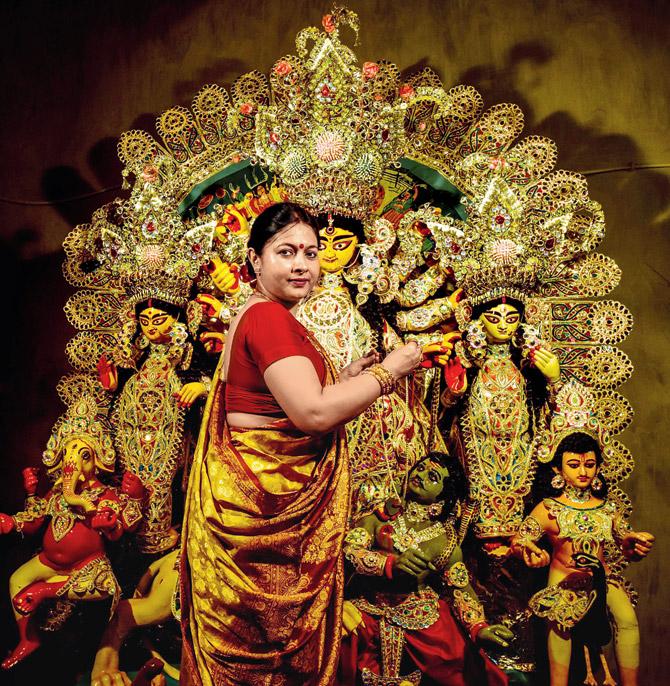
At the Banerjee bari, Meenakshi Banerjee puts a gold and pearl necklace on the idol before the Shashti evening puja
It was perhaps around this time that family rituals around Durga Puja began to take on their unique form. For instance, the first Bengali millionaires, Chhatu Babu and Latu Babu, were famous for their idol that was flanked by Jaya and Bijaya, instead of Lakshmi and Saraswati. In Pathuriaghata's Ghosh bari, the hilsa, mutton biryani and a sandal paste-infused kheer were the star attractions, as was their lobster dish known as Chingrimacher Chine Kebab, while the Basu Malliks of Potoldanga are still remembered for their famous gun salute to the goddess.
The Basu Malliks say that their founder patriarch Radhanath was perhaps one of the first Bengalis to learn English, and reportedly built 40 mansions before dying at the age 44. One of his grandsons, Kshetra Chandra Basu Mallick, started the Durga puja with the ritual of firing guns to announce the Sandhi Puja — the exact moment the 8th lunar day meets the 9th. It is at this moment, the Devi was said to have killed the Chanda and Munda forms of Asura, and was later venerated as Chamunda.
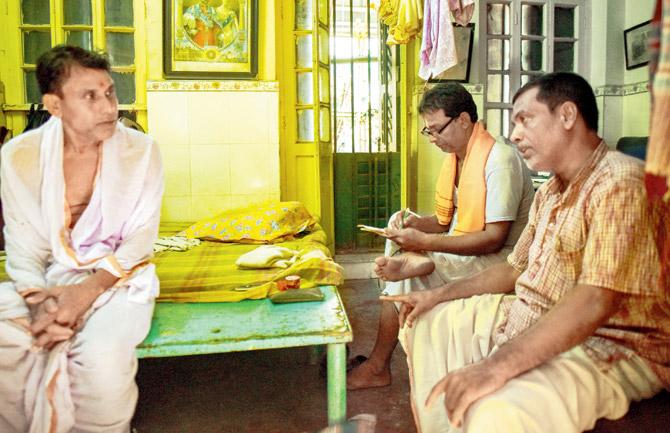
The Brahmin purohits have a separate room at the Narasingh Chandra Daw bari
Says Srikanta Basu Mallik, a family member, "It is not known why this gun salute actually started, but even today everyone in the neighbourhood waits for us to fire the guns before starting the Nabami rituals." Interestingly, this clan does not offer any anna (rice) bhog to the goddess. In its place, is a sumptuous spread of all kinds of fried stuff and fritters with heaps of perfectly rounded luchis. This family also offers a symbolic bali (sacrifice) on the ninth lunar day, nabami. Earlier, it used to be a goat that was sacrificed, and its meat prepared as prasad. "After an unfortunate incident, the goat had to be replaced with a symbolic fruit — we use sugarcane now," Basu Mallik says.
The mutton bhog ritual, however, is still prevalent in other homes and is closer to the 'Jain mutton curry' — without onion and garlic. Fish is also offered in some homes, such as the Jagat Ram Mukherjee family mansion in Behala, that hosts an idol made of solid gold. In other homes, the naibedya, which is the key offering to the god or goddess who presides over the ceremonies of the day, takes on a sweeter note, as it happens in the Banerjee Bari at Patuatola Lane.

The 'Shri Gora' Meenakshi makes on Shashti after the morning puja rituals
This elaborate spread is made of 108 mounds of sugar topped with narkoler naru (coconut laddoos), symmetrically placed on a massive brass thali. This pujo was started in 1890, by Beni Madhob Banerjee, the first Indian attorney. "Every year they are offered for the well being of all the children in the family," says Meenakshi Banerjee, a family member. On the day of Shashti, after the morning rituals are over, she sits down in a quiet corner to build a little colourful pyramid with rice paste in five colours — red, yellow, green, blue and black. It is called the "Sri Gora" and has its roots in folk lore.
The Daw family of Jorasanko, descendants of Shib Krishna Daw, who owned a successful mining business, takes pride in their impeccably maintained mansion, that has been the backdrop of many feature films and ads. Some of their rituals have been in practice for over 160 years. One of them involves the women of the house gathering after Mahalaya, to make soft, coconut-based sweets meant to last through the five days of the puja.
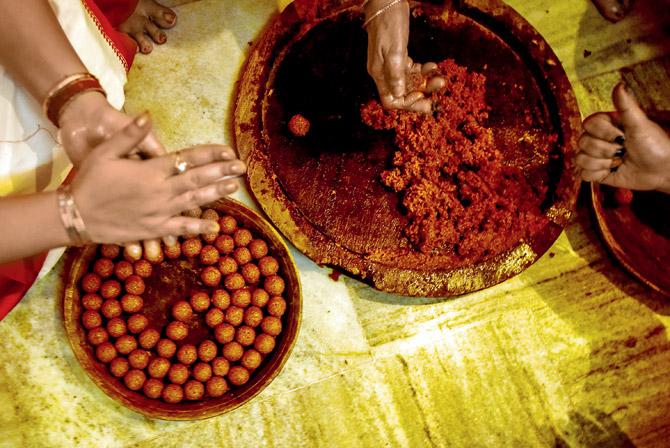
Narkoler nadu at Jorasanko Daw bari
Given that a few hundreds are fed every day, the quantities are huge. Watching these women dressed in antique gold jewellery and the quintessential red-bordered silk saris, huddled around heaps of shaved coconut, rolling them into little balls, is a visual treat. The scene is a little different at the home of the descendants of Narasingh Chandra Daw, who have traded in spice and guns over centuries. They maintain a brightly painted thakur dalan with cast iron arches and slender pillars. The women don't prep the bhog themselves, but play an important part in overseeing the proceedings. Here too, the sweets are prepared every morning to be consumed through the day. There is a steady stream of relatives, friends, visitors and no one goes back empty handed.
History turns sweeter at the Roy Chowdhury's — their Sabarna Praanmohini being a signature sweet of the family. The Roy Chowdhurys are the ones who transferred their rights of Kalikata (later Calcutta) to the East India Company, altering the course of history forever. The family's first Durga Puja was held in 1610 and today, the family hosts eight pujas across their properties. There are 13 kinds of sweets and savouries that are unique to this family, but their star offering is the Praanmohini, a sweet dish made with parwal. One of the descendants, Devarshi Roy Chowdhury, says that the recipe dates back to 1850, when women would cook it and serve it on silverware to the goddess and then to the guests. It is a rich melange of parwal, ghee, milk raisins, cashew nuts, saffron and rose water, moistened in sugar syrup. Clearly, devised for a generation that had fewer health concerns.
Head to the Sovabajar Raj Bari and you'll find the grand old matriarch, Arati Deb, the busiest person at this time of the year. The septuagenarian hobbles from one end of the thakur dalan to another, participating in the prayers, chants and the readings of the scriptures. She also oversees the preps of the bhog, a stunning combination of sweet and savoury with samosas, motichoor laddoos and an assortment of deep fried sweets with a longish shelf life, on offer.
The five days of the Puja sees thousands of visitors stepping into the palace. The elegant white mansion with its brilliantly illuminated thakur dalan is still one of the finest in the city, as is the bhog that's prepared inside. There is very little in Kolkata that would do justice to its forgotten monicker — City of Palaces. But, Durga Puja is that magic wand that can transform even the most decrepit places into something mystical, alluring. And, what better way to go back in time than to bite into a piece of history.
 Subscribe today by clicking the link and stay updated with the latest news!" Click here!
Subscribe today by clicking the link and stay updated with the latest news!" Click here!







